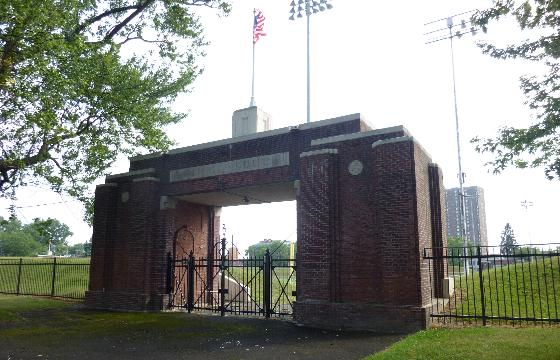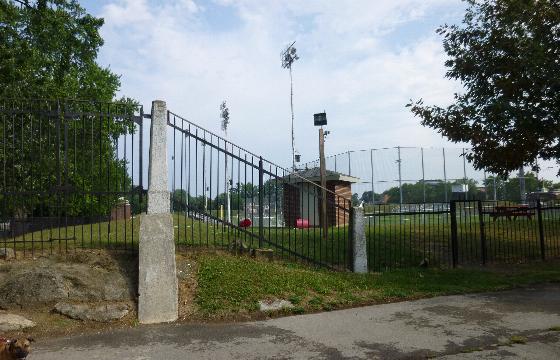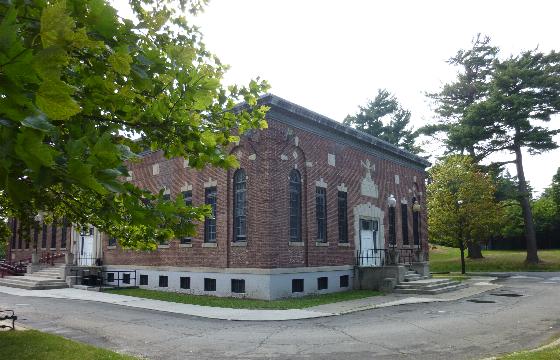 Second Street entrance to Bleecker Stadium, Aug-2012. |
 A view of the baseball field from outside another gate. |
 The separate clubhouse facilities, built a few years after the stadium opened. |
 Second Street entrance to Bleecker Stadium, Aug-2012. |
 A view of the baseball field from outside another gate. |
 The separate clubhouse facilities, built a few years after the stadium opened. |
The stadium takes up about half of a long block (Swinburne Park, a passive recreation area and playground, takes up the other half). The parcel’s length makes the site ideal for football and soccer as well as baseball; indeed, the football field and the baseball field do not overlap. The baseball diamond is in the north corner, nearest the clubhouse. The stands are built into the embankment of the prior reservoir; the entrances are cuts in the embankment.
In 1971, a sportswriter who also hosted a call-in radio show started talking about the old Albany Senators, who had been in the Eastern League from its 1923 founding through 1959, when they folded. (Their old ballpark, Hawkins Stadium, was razed in 1960.) The resulting flood of nostalgia led to Pittsfield’s team in the Eastern League, forty miles away, relocating their August 19 game against Reading to undersized Bleecker Stadium. The one-off between these Senators, a Washington farm club, and the Phillies drew 7,760 fans, their biggest crowd of the season, far outdrawing the capacity of Wahconah Park – and, indeed, Bleecker Stadium, which could not seat more than 2,000 comfortably for baseball. (The R-Phils won the game, 4-3, with Mike Schmidt hitting two home runs.)
Soon afterward, the Montréal Expos proposed to move their International League team from Winnipeg to Bleecker for 1972, but doing so proved logistically impossible. The stadium was still used for high school football and track, and a permanent improvement would entail enlarging the outfield and cutting off the running track. There were also issues with neighborhood parking. The Pittsfield Rangers (their American League parent had relocated to Arlington, Texas, for the 1972 season) came into Bleecker for four games a year in 1972 and 1973, but the crowds quickly dwindled and the series soon ended.
A decade later, the West Haven A’s relocated to the Capital District and played one season at Bleecker Stadium before Heritage Park in nearby Colonie was ready for use. Heritage Park saw just 19 years of use before it was demolished; meanwhile, Bleecker Stadium is in its ninth decade, and it is still used by two high schools in Albany. The College of Saint Rose also used the facility through 2009 before moving to a complex at Albany’s Hoffman Park for 2010; the Dutchmen of the New York Collegiate League, a college summer league, used it for a time as well but have also moved to the Saint Rose field.
Coincidentally, the last Major League Baseball-affiliated team from Pittsfield wound up moving to the Capital District. The 2001 Pittsfield Astros of the short-season New York-Penn League became the 2002 Tri-City ValleyCats, playing across the Hudson at Bruno Stadium on the Hudson Valley Community College campus in North Greenbush.
I was not able to get into Bleecker Stadium on my 2012 visit.